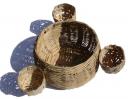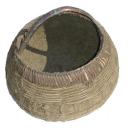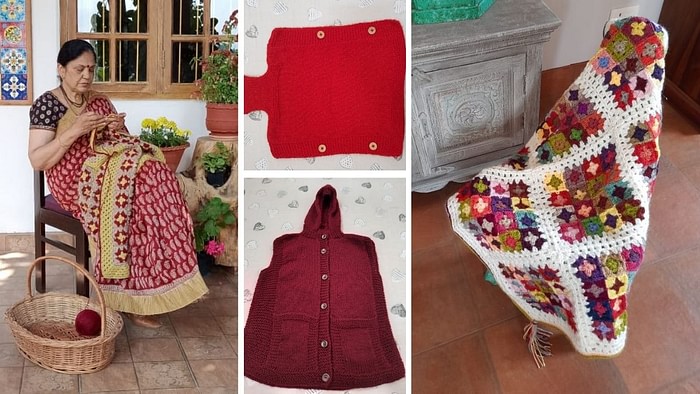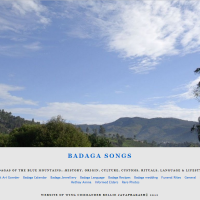also.. crops grown, implements used etc
Dedicated to the memory of the Great Badaga Leader Rao Bahadur H B Ari Gowder
Website of Wing commander Bellie Jayaprakash
 >>Tea Leaves… the crop on which Badaga ‘economy’ depends so much..
>>Tea Leaves… the crop on which Badaga ‘economy’ depends so much..
The agricultural produce, food, dishes, eating habits and some interesting recipes of Badagas.
Apart from badaga.org, I am thankful to N.Bellie, R.Ramachandran (Kekkatty) and others for their imputs. A lot of info is from Prof.Paul Hockings’s books.
In this page I have tried to discuss and describe, not only of authentic recipes on Badaga dishes but also on their agricultural produce, known in Badaga language as BAE – like for example Badagas used to grow wheat, barley, millet – GHODUME, GANJE, ERAGI, BATHA –etc but have almost completely stopped now.
The food, eating habits, preparations of some dishes as well as the ingredients used will be covered. And of course the methods used in cooking (like in a mud pot known as MADAKE in traditional fire place – OLE)
Belle Keere, Baththa, Kappu Keere
It must mentioned that though many masala powders are available in the market, the Badagas use a specially prepared curry powder known as ‘ BADAGARU MAASU HUDI’ in their preparations.
I remember my childhood days when the dried GANJE / GHODUME (barley/wheat) used to be spread in the fore court of the houses called KERI (street) , between two groups of Hatti HEMMAKKA (ladies) squatted opposite to each other with GANJE DHADIS (sticks of about four feet long and an inch thick) systematically & alternatively beating to remove the chaff. The rhythmic ‘tak tak’ noise would be accompanied by some folk lore Badaga songs. This is known as GANJE SACHODHU.
How can anyone forget the GANJE that would be HURUTHU – fied (fried) in a HURI MADDAKKE (mud pot with a hole on its side) through which a HURI KOL (a short stick with cloth tied at one end as a ball) would be inserted and the contents stirred constantly for uniform frying?
Huri Maddakke >
The fried ganje called GANJIKKE would be taken with BELLA (jaggery) and THENKE (coconut). The taste of this would increase if hurutha keerai is added. Used to be a very common snack during the “kodai” season when no one can venture out on account of severe wind and rain.
This ganjikke would be powdered in a ‘ BEESA GALLU ‘ or ‘BEESARAN KALLU’ ( grinding stone ‘flour mill’) that was a permanent feature in the EDHA or NADU MANE and stored for furture use. People who go on long journeys (in olden days travel was by foot only) took this powder along with them, a very handy and healthy meal. This powder would be mixed with hot water to make a gruel. Salt and jaggery could be added to taste.
Edha Mane (notice the Beesa Gallu (Grinding Stone-mill) at the right bottom corner. The corner is called GOTTU MOOLE) – Illustration by Bellie Jayaprakash
MAJJIGE KADANJODHU or HAALU SORAKKODU( milk churning ) used to be a routine job and great fun for the children in trying their hands. The BENNE (butter) and THUPPA (ghee or clarified butter) are very healthy. When taken with ERAGI HITTU (wheat ball in the size of cricket/hockey ball), it is very tasty.
EEGAVE THIMBUDHUGA AASE BANDHARAVA ? (don’t you feel like eating now )?
POTHITTU (wheat dosai) has to be an all time favourite of Badagas. During SAKKALATHI HABBA (the last festival before HETHAI HABBA ) POTHITTU with THENKE NEERU (coconut water) is the main dish.
What about dishes like OTTU KUDI UDAKKA (bamboo shoot curry) which can put any BAADU UDAKKA (non veg curry) to shame?And KOONU (mushroom) preparations?
There are many side dishes like SOPPU, BARRATHA AVARE , GAASU SANDEGE Then the question of how to ERAGI HITTU HOKKUDU (make wheat ball?) or make HABBA (festival) specials like BADE (vadai) KAL KAL (sweets made out of maida) etc etc.
Talking about chutney – GAASU SANDEGE , when GAASU (potato) is cooked in KENDA (ember) – SUTTA GAASU – and mixed with UPPU & OLLIYA MAASU (salt & pepper) it really tastes great ……umm…really mouth watering.
Incidentally, a DODDARU SHULOKA (Badaga Proverb) goes like this ;
“GHANDA (GHANDU) ILLADHA MANE HOLLA, GAASU ILLADHA UDAKKA HOLLA” meaning : –
” without a man(husband), house is bad ; without potato, curry is bad “.
I was pleasantly surprised to know that Taj Garden Retreat hotel in Coonoor (in the Nilgiris) serves some exclusive Badaga specials like THUPPADITTU & OTTU KUDI curry.
“Since the British lived here for long, there was a mix of the English food with the local ingredients – mostly, the native Badaga food. Thuppathittu, is an example. That makes it different from the typical English food…..For vegetarians, … Ottakudi Gassu poriyal ( a typical Badaga food of potatoes, spices and bamboo shoots), …. Avarai Uthaka (traditional Badaga speciality), Khuni khichri (spice preparation) and Gassu Dhotti (boiled potato preparation)”
http://www.expresshospitality.com/20050808/viewpoint02.shtml
Rasam is called MAASU NEERU ( milagu thanni in Tamil that has found its way into dictionaries).BATHA HOKKUDHU was done by elephants in ancient period, and till a few decades ago, by 50 to 60 bulls and cows brought from the plains (mainly Avinashi near Coimbatore) to the villages and mostly done during night time. One of the methods/processes in storing/pruning our farm produce ERAGI (millet) is known as ” ERAGI METTODHU ” (Stamping).
This is done on the green ERAGI stems freshly harvested from the fields. A bunch of this is put indoors on the floor and squeezed by bare feet . This is done mainly in the night in the EDHA MANE (middle room) and stored in the DHARSAE PETTI / BALLA (storage basket) which is located on top of the HAGALAE (permanentally fixed long wooden plank from wall to wall that also served as a huge cot) in the EDA MANE . See the illustration above.
BALLA or BALLA PETTI is a big cylindrical basket for storage and fixed to the wall/floor by cow dung. There would be hole at the bottom to take out the grain. The hole is sealed with cow dung and removed whenever required. Smaller storage basket is called KUKKE. Depending on the usage they are known as BENNE KUKKE (butter basket), HUYIGAL KUKKE (multi utility basket), DODDA KUKKE (big basket) with a handle to carry mud to clean the temples before puja in the olden days and of course, the GANJIKE KUKKE with smaller baskets attached to a central bigger one used in SAVU (funeral) rites. MAKKIRI was a larger basket used to carry food items to fields (HOLA) and on long journeys.
Different types of Kukke
BESAKATTI is a large flat basket, used for drying grains, hung above the fire place/ hearth ( OLE ) in the inner room (OGE MANE) of a Badaga Home during earlier days.The basket is suspended from the beam with wire rods /ropes (KANNI).
There are a lot of DODDARU SHULOKAs on BALLA (storage container for grains). A couple of them are listed here :
“Ballada hattale siri, Kukkeya hattale uri” ,
“Baavava balla ethone getta, badava baathu satha “
***********************************************************
BADAGARU KOI UDAKKA (Badaga Chicken Curry) by Anitha Gokul
KOI UDAKA MAASU HUDI (Masala powder for chicken gravy) by Anitha Gokul
UDAKA MAASU HUDI (for other gravies) by Anitha Gokul
~~~~~~~~~~~~~~~~~~~~~~~~~~~~~~~~
Some More Recipes (courtesy badaga.org)
THUPPADHITTU (Enne Hittu) ‘A SWEET DISH’ by Anitha Gokul
BELLE BENGUVAE SANDEGE [GARLIC SIDE DISH] by Anitha Gokul
EERA BENGUVAE SANDEGE (ONION SIDE DISH) by Anitha Gokul
BELLE BENGUVE MAASU NEER by Sangeetha Bheeman
BADAGA CHICKEN SPECIAL
KADAMITTU by R Ramachandran (Kekkatty)
HATTCHIKE by R Ramachandran
To read the complete recipes (articles) go to https://badaga.wordpress.com/recipes/badaga-recipes
#########################################################
Badagaru Avare
Badagas usually grow vegetables in their small patch(es) of land called ‘HOLA’ (see photo) for their regular use apart from other commercial crops like potato, cabbage, carrot and cauliflower etc. These would also include many varities of beans, peas, greens, corn etc. Every variety of avere(bean) has a specific (sometimes unique) badaga name. No Badaga wedding meal is complete without ‘Avare & Gaasu udakka’ [beans & potato curry]. Incidentally, Badagas do not serve non-vegetarian (meat) dishes on the wedding day , main meal is called – ‘maduve hittu‘. Another great trait among these simple peasant people is called ‘nattu‘ – a sort of gift (again mainly the home grown vegetables & grains) given to relatives, friends and guests.
Different types of beans AVARE (pronounced – ava ray) grown by Badagas :
Cleaning rice ( kallu hirurukkodu)
No articles, images and other material in this website can be reproduced without the written permission of
Wing Commander Bellie Jayaprakash B.E.(GCT,Madras Univ).,M.B.A (FMS, Delhi Univ)
Contact : bjaypee@gmail.com
Bellie.Jayaprakash©2024
:::::::::::::::::::::::::::::::::::::::::::::::::::::::::::::::::::::::::::::::::::::
Discover more from Badagas of the Blue Mountains
Subscribe to get the latest posts to your email.























 Mookuthi
Mookuthi  Chinna
Chinna 






 ==
==














































Pingback: The Enterprising Badagas | Badagas of the Blue Mountains
Can anyone tell about poparai ( in Baduga). Its an traditional food of our Badugas…
LikeLike
Wonderful informations are found in this site.Proud of being a Badaga..We really ROCK!
LikeLike
Hello JP….I am Magesh Hirian from Kettti Acchanakkal(live in the USA now)…….I am a very proud Badaga and and a great admirer of our heritage and culture….. I am completely blown away with this website. Please keep up the good work. This is awesome!! love it.. na endhu enna Hethai Ammana mathi..
LikeLike
i lik to eat it!!!!
LikeLike
A Fantastic going…and i will do my level best to make this site more valuable with other information.I heartily appriciate this effort and im proud to leave a comment.
All the best.
LikeLike
Great effort and Great News! Impressive! இது நங்க படுகரு சமுதாய மக்க எல்லா ஓத பேக்கத ஒந்து ஒள்ளிய வெப்சைட்.
LikeLike
I have a question , were badagas non vegetarians in the past too? Is there somethng about this in the history, will be great if you can let me know?
LikeLike
proud to b a baduga………
LikeLike
I am very happy to see this badaga website.thousands of thanks for the gentleman who did this excellent job. PROUD TO BE A BADAGA.
LikeLike
I love Baduga, one day I went to my friend’s house in Ooty for a day function. He is a Baduga. In that function, they were dancing in different style . I never saw that kind of dance. And Badaga people are also very humble . I really like Badagas.
LikeLike
Really fantastic… The things like EDHA MANE,DHARSAE PETTI / BALLA,HAGALAE clearly explains how our people were planned and prepared for their life in olden days. Its miserable that we are losing those treasures in todays busy life. There are somethings like ERAGI METTODHU,BATHA HOKKUDHU which nowadays are just in the stories that our elders (Hetthai,Ayya) tel to us. Our people were clear about what is good and healthy for us. Also the different recipies for different seasons were in such a way to defend ourselves from diseases.
Your work is simply amazing JP. I thank you on behalf of youngsters for letting us know our cultures value.We really feel proud to be badaga. We are getting to know a lot of things about our civilization. Thanks a ton! Continue your superb work.
LikeLike
nee bandhu ethaiya mookuthi minidhengae endhu nee menoodhu endhu enga vazhthiniyo! [we wish that you shine like the shining nose ring of Hethay].
LikeLike
Ya, its very interesting and amazing..
LikeLike
superb job ,thanks for doing this. continue with our great baduga culture…..
LikeLike
Jayaprakash avakaga enna kodi namaskara. Ninga appara olleya vishaya madithi.
Nanga Samudhayatha neraiya maradhotha vishaya ellava ollangey vilakki baradhuthi.
Enna kunna vayasudho, enga manathogey Eragi mettithathu, Ganjey Chachithathu, Onakkey , Oralutho Eragiya arathathu , Kaddha Gasuna Besi Thinthathu endhu ellava enaga gena
madithathuga appara nanri.
LikeLike
please send some recipes
LikeLike
I m very happy to see a website specially about Baduguru.
Hats off for those who worked hard to bring up this website. I used to think that we do not have script and so our culture may not survive for long time. But now m happy about this site. I do not find words to express my happiness. Great job!!!!!!!!!!
LikeLike
really it is super
the articles in this site very useful. good work
keep it up.
k. subramanian
senior lecturer in commerce
govt.polytechnic college for women
coimbatore – 44
LikeLike
There is no words that say thank you enough for everything you have done.I really do appreciate you and admire you very much.Its an uphill task, but I know you can do it.
LikeLike
All the photos and the food habits are good. Specifically your illustration
“Edha Mane (notice the Beesa Gallu (Grinding Stone-mill) at the right bottom corner. The corner is called GOTTU MOOLE) – Illustration by Bellie Jayaprakash” is an excellent piece of work. Though, you have missed an ORRALLU nearby the Beesa Gallu, which I have seen in many of our Badaga home including my ayyana hatty..Achanakal..as it is the Dodda Mane for the hatty. I suggest you can add that too in your illustration.
LikeLike
After seeing and reading the whole information, I just closed my eyes and was able to rewind my younger days , when I used go to my mother’s native place (Bembatty, near Itthalar), for my holidays and festival time with my sister Usha, where I used sit with my cousin and have food and I remember on top shelf I could see all the different types of beans AVARE, different types of Kukke, where the BELLE BENGUVAE and avare are kept for cooking.
Thanks, I could smell the smoke of the ‘flame’ very strongely , if am living far away ..keep adding more, do things differently
LikeLike
There are two more badaga spl.
1) Iri Dhoti ( Kinnakorai Spl )
2) PothHittu
For the recipe details I’ll be get back to you soon
LikeLike
The whole web site is so wondeful , its got amazing pictures and of course explainations , i’m a Badaga by birth, but married to a Tamilian . Never got an opportunity to show my husband or my in-laws and my husband’s relatives the hutties and the unique Badaga culture and tradition ever since I was married ; this site had help me a lot in conveying them the right information abt Badaga culture and tradition. Thanks .
LikeLike
Wonderful collection…….
I am badaga from Mukkimalai hatti
LikeLike
naa badugu tha….. thuneri…. ninga supera maadethee.
LikeLike
Let us all share the information available on badagas and their culture among all badagas.
some of your regular visitors of this site may visit
http://www.dubaibadaga.org.
Moghan mathiah
LikeLike
nice information
LikeLike
wow, great
LikeLike
All said & done… our “avarai” udhukka is unique .. nothing to beat that.. I am in for “Avarai Udhukka & Masneer with Uppu Korai ” 24X7..
LikeLike
Wonderful collection about our great culture.
I am really impressed by your hard work about our culture.
– Kukkal Bellan Balasubramanian
LikeLike
its simply superbbbb…
LikeLike
Thank you very much Anitha Gokul.
With the good wishes from people like you, I must give a serious thought to writing a book.
Regarding Badaga chicken curry, Pl write a recipe so that an authentic ‘Badaga Koi Udakka ‘ can replace the present one.
Infact, it was your recipes in ‘badaga.org’ which prompted me to add this page.
LikeLike
I am really impressed by the work you are doing. I think you should write a book about the Badagas.
The badaga chicken curry recipe you have here is not the tradional one we usually prepare. usually coconut is not used for our uduka’s. we use a lot of small onions to thicken our gravies.
LikeLike